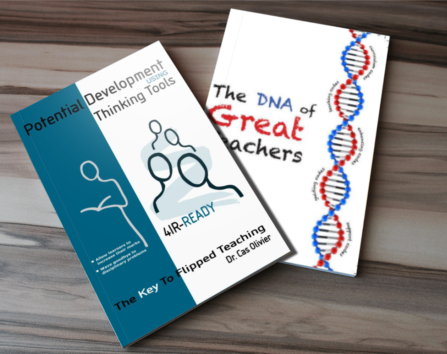The Brain Development Specialist
I established a teaching ecosystem that empowers learners to cultivate emotional and social intelligence, while nurturing self-regulation, innovation, and critical thinking.
Cas Olivier is a pioneering educator and the originator of the Inborn Thinking Tools concept. He specializes in evolving traditional teaching methods to align with the Fourth Industrial Revolution, emphasizing critical thinking and the generation of knowledge. Cas has crafted a distinctive methodology that frees students from memorization-based learning. His proficiency is in pinpointing deficiencies within educational frameworks and bridging them with groundbreaking ideas..
The Thinking Tools concept is a dynamic Fourth Education Revolution approach to teaching and learning aimed to cultivate lateral thinkers, innovators, and leaders from Generation Z students, who are products of the Third and Fourth Industrial Revolutions. These students, having grown up in an era of rapid technological advancements and global interconnectedness, need an education system that enables them to break free from silo thinking, where mastering knowledge is not the end but a means to an end.
About Learning Designs
The LearningDesigns website, founded in 2001, emphasizes that the quality of teaching and learning is greatly influenced by the mindset of the teacher. It suggests that when a teacher relies solely on PowerPoint slides for lesson design, it leads students to equate learning with rote memorization resulting in students becoming knowledge consumers.
When a teacher's lesson design incorporates engaging activities and questions that require students to discover and create knowledge, identify patterns, and solve problems, it empowers students to explain their reasoning and explore different viewpoints. This approach encourages students to analyze, evaluate, and synthesize information, providing a unique educational experience that transforms the way they learn.
This paved the way to discover this existence of the brain's innate Thinking Tools in 2010. The emphasis shifted then from the brain's holding capacity to its executive function, which operates like an air traffic control system, managing and coordinating the flow of numerous thoughts and ideas resulting in Zoom classes for teachers and learners from 2017 to 2021.
In 2023 the real-time Zoom classes were replaced prerecorded interactive online classes with WhatsApp support to enrolled teachers and students. The online classes are hosted on the Marvelous Minds.online learning platform which is the new brand name after establishing the Marvelous Minds PTY in December 2023.
The purpose of the LearningDesigns website is to host and share the core as well as the outcomes of our latest innovative research results.







